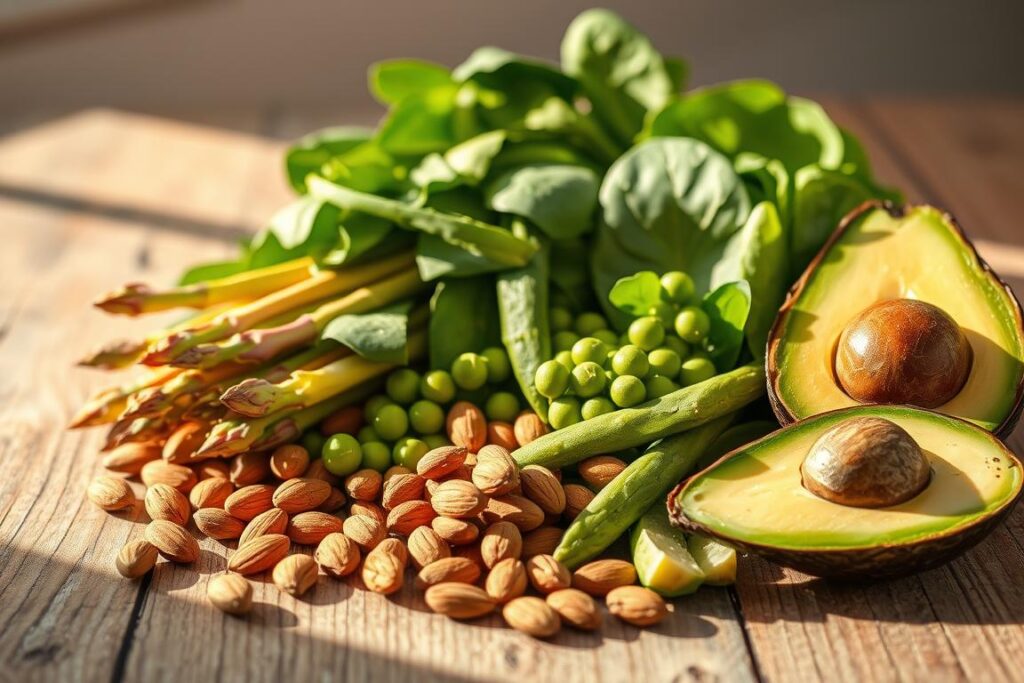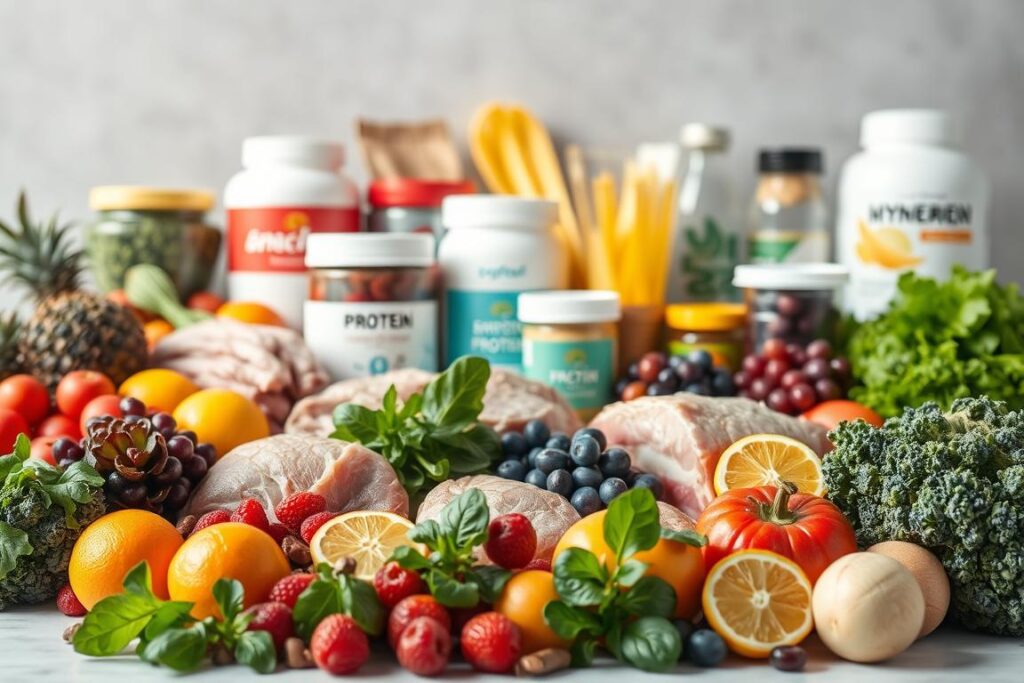
Seasonal Produce Guide for Muscle-Building Nutrition
The phrase seasonal produce for muscle building isn’t just a slogan — it’s a practical route to smarter training and better recovery. Want to cut grocery costs, eat tastier meals, and support your workouts with the right protein and carbs?
You’ll get clear picks by month and simple rules for pairing whole foods with lean protein. Expect batch-friendly meal ideas that save time and keep your diet consistent between lifts.
This approach boosts nutrient density and keeps joints and connective tissue healthy, so you can train harder and recover faster. Read on to learn how to pair timing, exercise, and food choices to actually build muscle without guesswork.
Key Takeaways
- Use in-season fruits and vegetables to stretch your budget and nutrition.
- Pair carbohydrates from fresh foods with protein after exercise for better recovery.
- Batch cook simple meals to keep post-workout nutrition consistent.
- Choose items that support joint health to maintain long-term training.
- Align food choices with goals: lean gains, strength, or recomposition.
- Smarter grocery planning improves flavor, nutrient density, and results.
Why seasonal eating is a smarter way to build muscle right now
Choosing foods at their peak makes every meal work harder toward your strength goals. How does timing what you buy improve training and recovery?
Higher nutrients and better flavor mean you eat more of the vegetables and fruits that feed your body without adding cost. That helps you meet protein and carb targets more easily.
Want to lift better and feel fresher afterward? Seasonal items lower grocery bills and raise quality. That lets you fuel exercise, support recovery, and keep weight and appetite steady.
How this guide maps food to training
- Summer: hydration and antioxidants to reduce exercise stress.
- Fall: complex carbs to sustain energy for strength work.
- Winter: mineral-dense foods to support contraction and repair.
| Season | Main function | Key sources |
|---|---|---|
| Summer | Hydration & recovery | Melons, berries |
| Fall | Energy & glycogen | Sweet potatoes, squash |
| Winter | Minerals & repair | Dark greens, root veg |
We’ll point to trusted sources and cite study-based claims where relevant. You’ll also learn the role of micronutrients and the risk of overrelying on supplements when whole foods are available.
Spring standouts: seasonal produce for muscle building
Spring brings a fresh set of garden picks that support strength, pumps, and faster recovery. Want a quick list you can add to meals?

- Beets: Natural nitrates raise nitric oxide, widening blood vessels to deliver oxygen to working muscles. Great as a pre-workout boost.
- Spinach: Also high in nitrates and about 200% DV of vitamin K per cup to support bone health during heavy lifts.
- Asparagus: Contains glutathione — an amino-acid antioxidant — plus folate and fiber to blunt inflammation when volume rises.
- Artichokes: Roughly 64 calories and 10 g fiber per medium item, with magnesium and potassium to help contraction and appetite control.
- Tart cherries & strawberries: Anthocyanins and antioxidants that cut soreness; one study links tart cherry intake to less exercise-induced damage.
- Peas: About 9 g protein per cup and a BCAA profile (including leucine), plus arginine and lysine to aid repair and nitric oxide pathways.
| Item | Key nutrient | Practical use |
|---|---|---|
| Beets | Nitrates | Pre-workout juice or salad |
| Spinach | Vitamin K | Base for salads with beets |
| Peas | Protein (BCAAs) | Mix into bowls or blends |
Summer fuel: light, hydrating picks that support muscle recovery in the heat
Training when it’s hot? You need food that cools you and helps you recover. Choose items that hydrate, add electrolytes, and deliver quick protein without heaviness.
Strawberries and cherries in smoothies
Blend berries with Greek yogurt to get vitamin C and polyphenols that lower exercise stress. This combo tastes light and aids recovery after intervals or circuits.
Edamame and beans
Edamame gives about 18 g protein and 8 g fiber per cup. Black, pinto, and kidney beans deliver ~15 g protein per cooked cup.
Why it helps: Protein and fiber stabilize energy and protect muscle mass during long summer days.
Leafy salads with spinach and beets
Make chilled bowls with spinach, sliced beets, citrus, and a can of tuna. Nitrates plus protein support performance in the heat.
- Hot day lift? Blend strawberries and cherries with Greek yogurt for faster recovery.
- Need portable protein? Pack edamame or mixed beans to add steady grams of protein and fiber.
- Prefer lighter meals? Use cottage cheese or yogurt bowls with fruits and oats to hit protein targets.
- Watch hydration levels: pair potassium-rich vegetables with water and a pinch of salt.
| Item | Key benefit | Quick serving |
|---|---|---|
| Edamame | High protein and fiber | 1 cup, 18 g protein |
| Berries | Vitamin C & polyphenols | 1 cup in a smoothie |
| Spinach + beets | Nitrates to aid blood flow | Salad with 1 can tuna |
Fall power foods: sweet potatoes, pumpkin, and beets for sustained training energy
Want steady energy for heavy lifts? Turn to sweet roots and squash this fall. These items give slow-release carbs and key electrolytes that keep your sessions strong.
Sweet potatoes
Sweet potatoes supply complex carbs, potassium, and antioxidants. Eat one before a big lift to drip-feed energy through your workout. The fiber and vitamin content also speed recovery afterward.
Pumpkin and other squashes
Squash brings beta-carotene, vitamin C, and fiber. Stir pumpkin puree into oats or yogurt. That combo supports immunity as intensity rises and helps joint function during higher volume weeks.
Beets, roasted or juiced
Beets boost nitric oxide, which can improve oxygen delivery in longer sets. Roast them with a palm-sized protein at lunch to prime an afternoon session.
- Swap refined carbs: build bowls with sweet potatoes or squash plus protein and greens.
- Try sheet-pan meals: chicken, sweet potatoes, and Brussels sprouts for quick performance-focused dinners.
- Aim for a palm-sized protein and a cup of these fall foods to balance glycogen needs and recovery.
| Food | Main function | Quick serving |
|---|---|---|
| Sweet potatoes | Steady carbs, potassium | 1 cup roasted |
| Pumpkin | Vitamin A/C, fiber | ½ cup puree |
| Beets | Nitric oxide support | ½ cup roasted or 100 ml juice |
Winter produce that keeps muscle on: hearty greens, potatoes, and citrus
Winter training puts extra load on your body; choose foods that match the demand. Short days and heavier blocks mean you need carbs, minerals, and immune support in every meal.
Spinach and dark greens: vitamin K and minerals to support function
Add a cup of cooked spinach to meals. It delivers near 200% DV of vitamin K and minerals that help bone and muscle function during heavy lifts.
Pair greens with grilled protein to boost calcium absorption and overall nutrient density.
Potatoes: versatile carbs to refill glycogen
Use white or sweet potatoes as a simple carb after long sessions. A hand-sized portion refills glycogen without excess fat and supplies potassium to steady contractions.
Combine a palm of protein with roasted potatoes to speed recovery and keep energy stable.
Citrus add-ins: vitamin C for connective tissue and immune health
Squeeze citrus into salads, marinades, or smoothies. The extra vitamin C supports connective tissue and helps your immune system during cold-weather training.
Keep protein steady at meals and add dairy or fortified alternatives for extra calcium. This protects bones and muscles when training intensity rises.
- Winter blocks often mean heavier loads—add dark greens for vitamin and mineral support.
- Portion potatoes with a palm of protein to refill glycogen and maintain training quality.
- Use citrus to lift flavor and support recovery and immune health in the cold months.
- If energy drops, increase carb portions from these simple foods and monitor training across the week.
| Food | Main benefit | Quick serving |
|---|---|---|
| Spinach | Vitamin K & minerals | 1 cup cooked |
| Potatoes | Glycogen refill & potassium | Hand-sized portion |
| Citrus | Vitamin C & immune support | 1 orange or ½ cup juice |
Turning seasonal picks into sports nutrition: macros, micros, and timing that work
Make your weekly plate a performance tool by tuning macros, micros, and meal timing to workouts. Start with clear targets and simple swaps you can repeat every week.

Protein target: Aim for 1.4–2 g/kg per day. Spread that across 3–5 meals. A post-session portion should contain 25–40 grams protein to drive muscle protein synthesis.
Carbs to power training: Use sweet potatoes, squash, quinoa, and brown rice before and after hard sessions. Match portion size to session length: brief workouts need 20–40 grams carbs; long sessions need more.
Fats that help: Add omega-3 sources like salmon, tuna, or walnuts in modest portions. Healthy fats support joints and hormone levels without displacing needed protein.
- Hydration & electrolytes: pair potassium-rich vegetables with fluids to maintain contraction levels.
- Leucine & amino acids: pick eggs, dairy, or soy to trigger repair and help you support muscle.
- Track intake weekly; if progress stalls, raise daily grams slightly before changing timing.
| Goal | Example serving | Why it works |
|---|---|---|
| Post-workout repair | 30 g protein + 40 g carbs | Refuels glycogen and boosts repair |
| Daily target | 1.4–2 g/kg protein per day | Supports muscle mass and recovery |
| Joint & hormone support | 1 serving salmon or 1 tbsp olive oil | Provides omega-3s and healthy fats |
Kitchen strategy: shop, prep, and mix produce to support muscle protein synthesis all week
Set aside an hour on Sunday and your weekday meals become predictable, nutritious, and fast. That small habit saves time and keeps recovery on track.
Batch-roast roots and squashes
Batch-roast sweet potatoes, beets, and squash to have ready post-lift carb sides. Roast on a sheet pan, cool, and store in airtight containers for 3–4 days.
Why it works: You plate a roasted carb next to a lean protein per meal without thinking. This speeds recovery and helps you hit grams protein targets.
Blend antioxidant fruits into recovery shakes
Blend strawberries or tart cherries with Greek yogurt or soy protein. You get double the protein of regular yogurt and antioxidant content that aids recovery.
Soy and edamame are complete plant sources and add key amino support. Need fiber? Fold in peas or artichokes to bowls and salads.
- Keep ready-to-eat foods: pre-washed greens, canned beans, tuna packets.
- Stock staples: eggs, edamame, Greek yogurt to make weekday prep effortless.
- Before a sports session, mix fruit and yogurt; after, add a larger protein and a roasted carb.
| Prep item | Quick use | Storage |
|---|---|---|
| Roasted roots | Post-workout carb side | 3–4 days fridge |
| Greek yogurt + berries | Recovery shake (grams protein) | Use fresh or frozen |
| Edamame/beans | Protein source in bowls | 5–7 days fridge |
Simple template: one lean source, one roasted carb portion, one colorful veg. Want to build muscle on autopilot? Start with this plate and repeat it all week.
Conclusion
Finish strong by turning food choices into reliable habits that back every workout.
You now have a season-by-season blueprint to train hard, protect muscle, and feed your body with foods that deliver protein, carbs, and key nutrients when they matter most.
Focus on daily protein and steady grams you can sustain. Add fruits, vegetables, roasted potatoes or sweet potatoes, and quality sources of amino acids like eggs, dairy, or soy.
Keep it simple: one protein per meal, one carb, one color. Use small shifts—more leucine, better timing—to support muscle protein synthesis and muscle mass over time.
Prioritize whole foods, limit unnecessary supplements, and pick one prep day. Start with two protein sources and three seasonal items this week to build momentum for health and sports nutrition.


